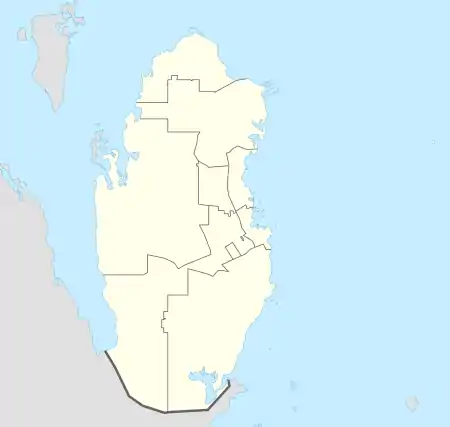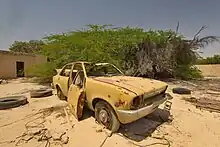Zekreet
زكريت | |
|---|---|
Village | |
 Zekreet Location in Qatar | |
| Coordinates: 25°31′22″N 50°49′41″E / 25.52278°N 50.82806°E | |
| Country | |
| Municipality | Al-Shahaniya |
| Zone | Zone 72 |
| District no. | 201 |
| Area | |
| • Total | 8.0 sq mi (20.6 km2) |
| Time zone | UTC+3 (AST) |
.jpg.webp)
Zekreet (Arabic: زكريت) is a village in north-western Qatar near Dukhan and about 80 km (50 mi) north-west west of Doha.[2] Originally a sparsely populated area, Zekreet was built up in the 1940s after oil operations commenced in Qatar. This included the construction of a harbor for oil equipment and a number of small houses which eventually developed into a village.[3] There are a number of visitor attractions and old ruins at the site, one of the most notable being Zekreet Fort, which is housed to the immediate north of the village.[4]
Etymology
The village's name is derived from the Arabic word "zikra", which in English translates to "memories". Originally, the name applied to a nearby rawda which had sentimental value for its inhabitants, but the name was eventually given to the village itself.[5]
Zekreet is also spelled as Zikrit and Zekrit. An area known by a similar name called Bir Zekrit (more commonly known as Ras Abrouq) is located north of Zekreet.[4]
Geography
Zekreet is situated near the bottom small stretch of land known as the Zekreet Peninsula which protrudes into the Persian Gulf and of which Ras Abrouq occupies the northern extremity.[4] Dukhan is the closest sizable settlement.[6] To the west of the village is the Bay of Zekreet, a half-moon shaped bay which in the past was an extension of the 20 km-long (12 mi) Dukhan Sabkha.[7] There is a cape protruding into the bay known as Ras Zekreet.[4] Much of the area is associated with erosional landforms such as foothills and mesas.[8]
History
Pre-20th century
.jpg.webp)
Zekreet was likely inhabited during the late 18th and early 19th centuries, the same era that saw the rise of the nearby northern settlements of Zubarah and Al Huwaila. Historic references to the area in the English language are scarce, but a local fort was mentioned by J.G. Lorimer, who claimed that it was built by the pirate ruler of Qatar Rahmah ibn Jabir al-Jalahimah in c. 1800. The village may have been abandoned around 1811, the same period that Zubarah was sacked.[6]
20th century
Oil was discovered for the first time in Qatar in 1936 in the nearby mountain range of Jebel Dukhan to the south.[9] The western side of the Bay of Zekreet, across the bay from the village, accommodated the first shallow-water harbor in Qatar to be used by oil companies to unload their equipment during the 1940s.[10] Food supplies and fresh water from Bahrain were also imported here. The growth and formation of the modern village of Zekreet was dependent on this harbor, however it was subsequently made obsolete by Mesaieed Harbor in 1952, and by the 1960s was decommissioned altogether.[11]
(2)%252C_village.JPG.webp)
Like most settlements in Qatar, seawater intrusion contaminated the coastal aquifers, therefore the contemporary village was established inland on the other side of the bay near existing water wells on the Zekreet Peninsula. Many inhabitants from eastern Qatar migrated to the Dukhan region in the 1950s to find work in the oil industry; notable tribes among these migrants being the Al Muhannadi, the Bani Hajer and the Na'im. Population estimates in 1950 put the number of men at 200 and women at 250 in the fledgling village. Zekreet opened its first primary school for boys in 1957 with a capacity of 45 students, making it the first settlement in the region to establish a formal school. A few years later, in 1960, the village's first primary school for girls was founded with roughly 26 seats. Throughout the late 1950s and 1960s, all inhabitants of the western industrial settlements sent their children to these two schools.[11]
Subsequently, the government decided to centralize all of the western region's infrastructure in the city of Dukhan, and so in the 1970s Zekreet's two schools were closed and its students shifted to the schools' replacements in Dukhan. The population of Zekreet sharply fell in the following years; by 1990 it was estimated that it had only 50 households. A majority of its residents were still employed in the energy sector.[11]
21st century
In January 2019, it was estimated that Zekreet had about 7,000 people living in the village, mainly expat workers.[12]
Industry
As of 2017, QatarEnergy LNG is in the process of implementing the $600 million Zekreet Gasoline Project.[13] It will eventually produce up to 75,000 barrels per day.[14]
Archaeology
(6)%252C_ruined_fortress.JPG.webp)

The first archaeological excavations at Zekreet took place in 1973–1974 by a team led by Beatrice de Cardi. Zekreet Fort was discovered during this period. The area was again excavated by a French team from 2002 and 2005 and the contents of this excavation were analyzed in 2006. The total area of the excavated site was 18,000 m2 (4.4 acres).[6]
Nineteenth-century ceramics have been discovered in situ. Some of the pottery has been traced back to China.[6]
Visitor attractions
Zekreet Fort
Zekreet Fort has been dated to the late 18th or early 19th century. The fort's shape is quadrangular with four circular watchtowers.[6] At the initial time of construction, the fort did not have any towers. The towers were instead added to each side in a reconstruction phase. Facilities for "debis" (date syrup) production are believed to have been at the site.[15]
Film City
A replica city was built to the north of Zekreet for use in film production. It includes a large fort surrounded by palm trees.[16]
House of the imam
The Qatar Museums Authority has embarked on a project to repackage a house belonging to the former imam of Zekreet during the 1950s as a cultural venue where educational workshops are held. As part of the repackaging, a passage will be constructed from the building to Richard Serra's sculptures in Ras Abrouq.[17]
Zekreet Mosque
Constructed in 1940, Zekreet Mosque has long been considered a local landmark and has since been restored by Qatar Museums.[18]
Zekreet Commercial Plaza
On an area of 6,692 m2, the Zekreet Commercial Plaza features 36 businesses, 31 residential units and several offices. Included among these businesses are restaurants, a bank, a post office, and a grocery store.[19]
Gallery
 Abandoned vehicle in Zekreet
Abandoned vehicle in Zekreet(3)%252C_village.JPG.webp) An old building in the village
An old building in the village Up-close view of the mosque in Zekreet
Up-close view of the mosque in Zekreet Reconstructed ruins on a limestone rock in the Zekreet Peninsula
Reconstructed ruins on a limestone rock in the Zekreet Peninsula Zekreet fort
Zekreet fort
References
- ↑ "District Area Map". Ministry of Development Planning and Statistics. Retrieved 13 March 2019.
- ↑ "Zekreet Beach". Online Qatar. Retrieved 10 July 2018.
- ↑ Al-Othman, Nasser (1984). With their bare hands: the story of the oil industry in Qatar. Longman Group. p. 49. ISBN 0582783755.
- 1 2 3 4 "Geographic Information System". Ministry of Development Planning and Statistics. Retrieved 10 July 2018.
- ↑ Jacques Leblanc (March 2008). A Fossil Hunting Guide To the Tertiary Formations of Qatar, Middle East (1st ed.). p. 72. Retrieved 22 February 2019 – via academia.edu.
- 1 2 3 4 5 Alexandrine Guérin; Faysal ʿAbdallah al-Naʾimi (2008). "Nineteenth century settlement patterns at Zekrit, Qatar: pottery, tribes and territory". Proceedings of the Seminar for Arabian Studies. 38: 173–185. JSTOR 41223947.
- ↑ Ian West; Maryam Mustafa Al-Mulla (2013). "Qatar Geology, Sabkhas, Evaporites and Other Desert Environments". University of Southampton. Retrieved 6 January 2016.
- ↑ Richtzenhain M, Al-Jaberi A, Böer B, Breulmann M, Darwish F, Dowling R, Grainger J, Llewellyn O, Muhannadi K, Pilcher N, Schwarze H, Southgate C, Sutcliffe M (2008). "Towards Environmentally Friendly Tourism in Arabian Biosphere Reserves; Case Study: Al Reem, Qatar". UNESCO Doha Office. p. 21. Retrieved 22 February 2019.
- ↑ Mirabella, Valentina (16 October 2014). "The Qatar Oil Concession Ushers in a New Era for British Relations With Doha". Qatar Digital Library. Retrieved 23 February 2019.
- ↑ Abū Nāb, Ibrāhīm (1977). Qatar: A Story of State Building. p. 59.
- 1 2 3 Fahd Abdul Rahmn Hamad Al-Thani (1992). The Spatial Impact of the Hydrocarbon Industry on Land and Sea Use in Qatar (PDF) (e-Thesis). University of Durham. p. 148.
- ↑ Fazeena Saleem (28 January 2019). "Significant contribution to Qatar's healthcare system". The Peninsula Qatar. Retrieved 28 February 2019.
- ↑ "Engineering Report 2017" (PDF). Qatar Financial Centre. 2017. p. 52. Retrieved 21 July 2018.
- ↑ "Zekreet Gasoline Processing Facility". ProTenders. Retrieved 21 July 2018.
- ↑ "Zekreet Fort". Explore Qatar. Retrieved 6 January 2016.
- ↑ "Film City, Doha". Online Qatar. Retrieved 6 January 2016.
- ↑ "متاحف قطر تنظم خمسة معارض في برنامج الربيع" [Qatar Museums is organizing five exhibitions in the spring programme]. Al Raya (in Arabic). 26 February 2015. Archived from the original on 20 July 2018. Retrieved 19 July 2018.
- ↑ "'Mosques in Qatar: Then and Now' Exhibition Opens at Museum of Islamic Art". Qatar Museums. 22 June 2023. Retrieved 11 October 2023.
- ↑ "Zekreet Commercial Plaza". waseef.qa. Retrieved 28 August 2021.